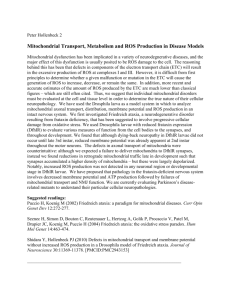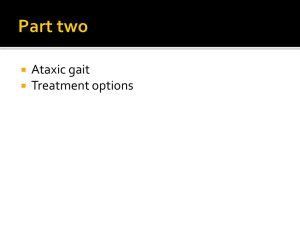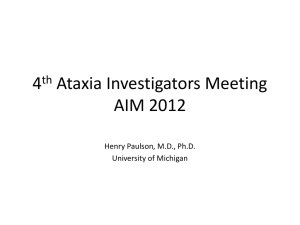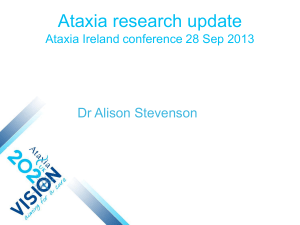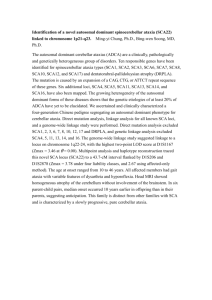Friedreich's ataxia
advertisement
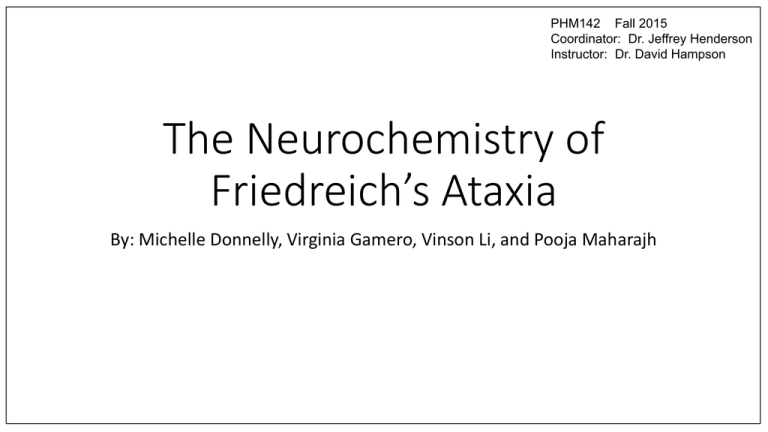
PHM142 Fall 2015 Coordinator: Dr. Jeffrey Henderson Instructor: Dr. David Hampson The Neurochemistry of Friedreich’s Ataxia By: Michelle Donnelly, Virginia Gamero, Vinson Li, and Pooja Maharajh Learning Objectives • • • • • • Define Friedreich’s Ataxia Understand the genetics of Friedreich’s Ataxia Recognize the gross pathology of the disease Understand the frataxin molecular mechanism Be able to list some signs and symptoms and why they are present in the disease Recognize the incidence of FRDA What does it mean to have Friedreich’s Ataxia? • Ataxia – “Lack of Order”- Greek • Defined as a loss of full control of body movements. • Generally the nerves that are affected can be missing from birth. • One of the most studied rare genetic diseases, and the most common Ataxia. Source: http://www.ninds.nih.gov/disord ers/friedreichs_ataxia/friedreich s_ataxia.htm • • • • • • • • • Friedreich’s Ataxia is A Genetic Disorder We first found out that the Friedreich’s Ataxia gene is on chromosome 9. The impacted gene is the FXN gene which transcribes fxn. Autosomal recessive disease Intron of FXN usually has a GAA triplet-repeat mutation Change in methylation pattern immediately upstream of exon 1 Inhibited transcription Leads to a deficiency in frataxin Sticky DNA Stabilized mRNA once transcribed The protein produced is normal. The problem is making it. Sources: http://www.fasebj.org/content/22/6/1625.full What does it mean to have Friedreich’s Ataxia? • The frataxin gene is expressed differently in certain tissues • High expression: liver, muscle, thymus, CNS, heart, pancreas, liver, skeletal muscle • Two determinants of pathology in high expression tissues: • Dividing cells (liver and muscle) versus nondividing cells (CNS, heart, pancreas) - affects regeneration • High metabolic requirements (CNS and heart) versus low metabolic requirements - affects toxicity Sources: http://www.mda.org/disease/friedreichs-ataxia/overview http://journals1.scholarsportal.info.myaccess.library.utoronto.ca/pdf/08878994/v28i0005/335_fa.xml What does it mean to have Friedreich’s Ataxia? *Decreased frataxin decreases NADH production AND decreases ISC’s, therefore increasing hydroxyl radical buildup. Sources: http://www.nature.com/nrn/journal/v5/n8/images/nrn1474-f2.jpg Decreased Frataxin decreases NaDH production * ** * * Proteins of oxidative phosphorylation * Note: Nature has stated they are referring the hydroxyl radical when they include OH-. • Frataxin is used to decrease • ISC = Iron-sulfur complex • Found in many proteins, especially those proteins involved in ETC (Electron transport chain). • Increases Fe2+ by decreasing Fe3+ and therefore decreasing OH radicals. • When Frataxin levels are low in cells where they are usually expressed (brain, cerebellum, etc- high metabolic rate), as in Friedrich’s ataxia, OH radicals rise, doing damage to neurons. Lowering Frataxin levels lowers ISC’s • Thus, increased iron in the cell causes increased running of the following pathway. • IscU Iron-Cluster Assembly Enzyme: Acts as a scaffold to assemble the cluster of Fe2S2. • Isu1p and Isu2p create Fe2 from the Us elemental iron pumped into the cell. • IscS = Cysteine desulfurase breaks down amino acids to attain sulfur and add it to the ISC. • Nfs1p adds the sulfur from the cysteine to the Fe2 complex • Recall: Increased iron is being pumped out of the cell in increased amounts. • Positive Feedback It’s all Connected! Us How common is Friedreich’s Ataxia? • FRDA frequency is 1:50,000 • Carrier frequency is 1:60 – 1:100 • FRDA occurs in populations from Europe, the Middle East, North Africa, and India and is absent in populations from East Asia and in Native Americans • Symptoms typically begin between 5-15 years • After 10-15 years, patients are usually wheelchair bound • The average life expectancy is 40-50 years • Most commonly reported cause of death are cardiac failure and arrhythmias Signs and Symptoms of Friedreich’s Ataxia Explained • Longer nerve tracts are usually most affected. • In the CNS: the long spinal cord transmits information to the brain and from the brain to the peripheral nervous system • Most notably affected: the cerebellum (no energy reserves) atrophies • Symptoms: difficulty with balance, walking, loss of coordination • In the PNS: the long peripheral nerve fibers that send information to the muscles and receive information from the periphery. • PNS signals fail to reach the muscles • Symptoms: weakness • Progression of symptoms: legs, arms, speech, vision, hearing. Source: http://quest.mda.org/sites/default/files/In_Focus-FA_2011_2.pdf Summary Slide- Friedreich’s Ataxia • Rare, but most common ataxia and most studied rare disease • Absent from East Asian and American Indian populations. • Autosomal recessive disease of FXN gene (GAA triplet-repeat mutation) on chromosome 9 that transcribes frataxin (fxn).-deficiency in frataxin via Sticky DNA and stabilized mRNA • Decreased frataxin decreases NADH and ISC production- increasing hydroxyl radical buildup. • Frataxin helps form ISC’s using Fe. So frataxin = ISC’s and Fe3+ and ROS. • ISC’s in proteins involved in ETC, so frataxin = NADH. • Frataxin helps IscU and IscS become Ns1p and isu1p and isu2p that make ISC’s from dietary iron and cysteine amino acids. • Increased Fe3+ pumped into cell accelerates this, so pathway has positive feedback. • FXN gene High expression and loss of function: cerebellum (no energy reserves), liver, heart, pancreas, skeletal muscle + others- where there’s high metabolic rate. • PNS signals cannot reach the muscles- Longer nerve tracts are more affected due to lack of energy production. • Lack of regeneration of dividing cells and toxicity to high metabolic rate cells. • Symptoms: difficulty with balance, walking, loss of coordination, overall weakness. Progression of symptoms: legs, arms, speech, vision, hearing. but Typically die of cardiac failure or arrhythmias Additional Sources http://www.fasebj.org/content/22/6/1625.full http://painresource.com/nervous-system/peripheral-neuropathies-friedreichs-ataxia/ http://www.nature.com/nrn/journal/v5/n8/full/nrn1474.html http://quest.mda.org/sites/default/files/In_Focus-FA_2011_2.pdf http://www.ninds.nih.gov/disorders/friedreichs_ataxia/detail_friedreichs_ataxia.htm http://patient.info/doctor/friedreichs-ataxia http://www.curefa.org/whatis http://www.ncbi.nlm.nih.gov/books/NBK1281/ http://quest.mda.org/sites/default/files/In_Focus-FA_2011_2.pdf http://journals1.scholarsportal.info.myaccess.library.utoronto.ca/pdf/08878994/v28i0005/335_fa.xml http://www.nature.com/nrn/journal/v5/n8/fig_tab/nrn1474_F2.html https://en.wikipedia.org/wiki/Friedreich%27s_ataxia https://en.wikipedia.org/wiki/Frataxin http://www.ninds.nih.gov/disorders/friedreichs_ataxia/detail_friedreichs_ataxia.htm
